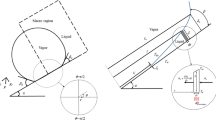Abstract
Investigation of microlayer formation characteristics is important for developing a reliable nucleate boiling heat transfer model based on accurate physical mechanisms. Although formation mechanisms of the thin liquid film in two-phase flow of confined spaces, such as micro-tubes and closely positioned parallel plates, have been thoroughly studied, microlayer formation mechanisms of pool boiling have been sparsely studied. In a previous study (Yabuki and Nakabeppu in Int J Heat Mass Transf 76:286–297, 2014; Int J Heat Mass Transf 100:851–860, 2016), the spatial distribution of initial microlayer thickness under pool boiling bubbles was calculated by transient heat conduction analysis using the local wall temperature measured with a MEMS sensor. In this study, the hydrodynamic characteristics of microlayer formation in pool boiling were investigated using the relationship between derived initial microlayer thickness and microlayer formation velocity determined by transient local heat flux data. The trend of microlayer thickness was found to change depending on the thickness of the velocity boundary layer outside the bubble foot. When the boundary layer thickness was thin, the initial microlayer thickness was determined by the boundary layer thickness, and the initial microlayer thickness proportionally increased with increasing boundary layer thickness. On the other hand, when the boundary layer was thick, the initial microlayer thickness decreased with increasing boundary layer thickness. In this thick boundary layer region, the momentum balance in the dynamic meniscus region became important, in addition to the boundary layer thickness, and the microlayer thickness, made dimensionless using boundary layer thickness, correlated with the Bond number.







Similar content being viewed by others
References
Yabuki T, Nakabeppu O (2014) Heat transfer mechanisms in isolated bubble boiling of water observed with MEMS sensor. Int J Heat Mass Transf 76:286–297
Yabuki T, Nakabeppu O (2016) Microscale wall heat transfer and bubble growth in single bubble subcooled boiling of water. Int J Heat Mass Transf 100:851–860
Moore FD, Mesler RB (1961) The measurement of rapid surface temperature fluctuations during nucleate boiling of water. AIChE J 7:620–624
Cooper MG, Lloyd AJP (1969) The microlayer in nucleate pool boiling. Int J Heat Mass Transf 12:895–913
Sharp RR (1964) The nature of liquid film evaporation during nucleate boiling. National Aeronautics and Space Administration, Washington, DC
Jawurek HH (1969) Simultaneous determination of microlayer geometry and bubble growth in nucleate boiling. Int J Heat Mass Transf 12:843–848
Voutsinos CM, Judd RL (1975) Laser interferometric investigation of the microlayer evaporation phenomenon. J Heat Transf 97:88–92
Koffman LD, Plesset MS (1983) Experimental observations of the microlayer in vapor bubble growth on a heated solid. J Heat Transf 105:625–632
Gao M, Zhang L, Cheng P, Quan X (2012) An investigation of microlayer beneath nucleation bubble by laser interferometric method. Int J Heat Mass Transf 57:183–189
Utaka Y, Kashiwabara Y, Ozaki M (2013) Microlayer structure in nucleate boiling of water and ethanol at atmospheric pressure. Int J Heat Mass Transf 57:222–230
Chu IC, No HC, Song CH (2013) Visualization of boiling structure and critical heat flux phenomenon for a narrow heating surface in a horizontal pool of saturated water. Int J Heat Mass Transf 62:142–152
Bretherton FP (1961) The motion of long bubbles in tubes. J Fluid Mech 10:166–188
Han Y, Shikazono N (2009) Measurement of the liquid film thickness in micro tube slug flow. Int J Heat Fluid Flow 30:842–853
Moriyama K, Inoue A (1996) Thickness of the liquid film formed by a growing bubble in a narrow gap between two horizontal plates. J Heat Transf 118:132–139
Zhang Y, Utaka Y, Kashiwabara Y (2010) Formation mechanism and characteristics of a liquid microlayer in microchannel boiling system. J Heat Transf 132:122403–1–122403-7
Lee RC, Nydahl JE (1989) Numerical calculation of bubble growth in nucleate boiling from inception through departure. J Heat Transf 111:474–479
Mei R, Chen W, Klausner JF (1995) Vapor bubble growth in heterogeneous boiling—I. Formulation. Int J Heat Mass Transf 38:909–919
Zhao YH, Masuoka T, Tsuruta T (2002) Unified theoretical prediction of fully developed nucleate boiling and critical heat flux based on a dynamic microlayer model. Int J Heat Mass Transf 45:3189–3197
Han Y, Shikazono N (2010) The effect of bubble acceleration on the liquid film thickness in micro tubes. Int J Heat Fluid Flow 31:630–639
Aussillous P, Quere D (2000) Quick deposition of a fluid on the wall of a tube. Phys Fluids 12:2367–2371
Acknowledgements
This work was supported by JSPS KAKENHI Grant (11J10651).
Author information
Authors and Affiliations
Corresponding author
Rights and permissions
About this article
Cite this article
Yabuki, T., Nakabeppu, O. Microlayer formation characteristics in pool isolated bubble boiling of water. Heat Mass Transfer 53, 1745–1750 (2017). https://doi.org/10.1007/s00231-016-1936-9
Received:
Accepted:
Published:
Issue Date:
DOI: https://doi.org/10.1007/s00231-016-1936-9




